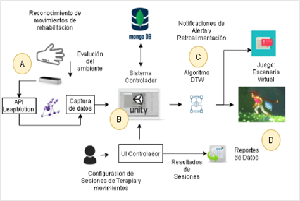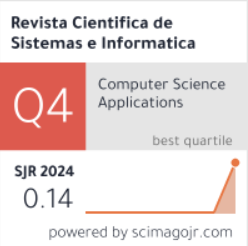Serious game for fine motor rehabilitation in children
design and usability considerations
DOI:
https://doi.org/10.51252/rcsi.v2i2.405Keywords:
superior members, virtual rehabilitation, optical trackingAbstract
Rehabilitation systems based on serious games have been developed not only to measure the precision of movements but also to motivate and achieve a greater commitment to the exercises performed, even more so when the patients are children. This article presents the development of a serious game for the motor rehabilitation of children between 7 and 13 years old. For this, the Leap Motion device was used, taking into account the attributes of virtual rehabilitation systems for therapies: observational learning, practice, motivation and feedback. To test the usability of the system, the specialized questionnaire for virtual rehabilitation systems for therapy Suitability Evaluation Questionary (SEQ) was used. The results showed the acceptance of the system not only at the level of functionality but also of not presenting discomfort in terms of dizziness, nausea, eye discomfort, among others. Being able to have the results of the SEQ has made it possible to identify improvements in terms of design and usability considerations.
Downloads
References
Bachmann, D., Weichert, F., & Rinkenauer, G. (2018). Review of Three-Dimensional Human-Computer Interaction with Focus on the Leap Motion Controller. Sensors, 18(7), 2194. https://doi.org/10.3390/s18072194
Blake, H. L., & McLeod, S. (2018). The International Classification of Functioning, Disability and Health: Considering Individuals From a Perspective of Health and Wellness. Global Issues in Communication Sciences and Related. https://doi.org/10.1044/persp3.SIG17.69
Chen, K.-H., Lin, P.-C., Chen, Y.-J., Yang, B.-S., & Lin, C.-H. (2016). Development of method for quantifying essential tremor using a small optical device. Journal of Neuroscience Methods, 15, 78–83. https://doi.org/10.1016/j.jneumeth.2016.03.014
Cortés-Pérez, I., Zagalas-Anula, N., Montoro-Cárdenas, D., Lomas-Vega, R., Obrero-GaitánEsteban, & Osuna-Pérez, M. C. (2021). Leap Motion Controller Video Game-Based Therapy for Upper Extremity Motor Recovery in Patients with Central Nervous System Diseases. A Systematic Review with Meta-Analysis. Sensors, 21(6), 2065. https://doi.org/10.3390/s21062065
De Oliveira, J. M., Fernandes, C. G., Pinto, C. S., Pinheiro, P. R., Ribeiro, S., & C. de Albuquerque, V. H. (2016). Novel Virtual Environment for Alternative Treatment of Children with Cerebral Palsy. Computational Intelligence and Neuroscience, 2016, 1–10. https://doi.org/10.1155/2016/8984379
Filho, I. A. S. (2018). Gesture Recognition Using Leap Motion: A Machine Learning-based Controller Interface. In Computing Track (p. 5). Sciences of Electronics, Technologies of Information and Telecommunications (SETIT). https://www.researchgate.net/publication/333759237_Gesture_Recognition_Using_Leap_Motion_A_Machine_Learning-based_Controller_Interface
Friedman, N., Chan, V., Reinkensmeyer, Andrea N Beroukhim, A., Zambrano, Gregory J Bachman, M., & Reinkensmeyer, D. J. (2014). Retraining and assessing hand movement after stroke using the MusicGlove: comparison with conventional hand therapy and isometric grip training. Journal of NeuroEngineering and Rehabilitation, 11(76). https://doi.org/10.1186/1743-0003-11-76
Gil-Gómez, J.-A., & Manzano-Hernández, P. (2013). SEQ: Suitability Evaluation Questionnaire for Virtual Rehabilitation Systems. Application in a Virtual Rehabilitation System for Balance Rehabilitation. 7th International Conference on Pervasive Computing Technologies for Healthcare and Workshops, May, 1–5. https://doi.org/10.4108/pervasivehealth.2013.252216
Iosa, M., Morone, G., Fusco, A., Castagnoli, Marcello Fusco, Francesca Romana Pratesi, L., & Paolucci, S. (2015). Leap motion controlled videogame-based therapy for rehabilitation of elderly patients with subacute stroke: a feasibility pilot study. Topics in Stroke Rehabilitation, 22(4), 306–316. https://doi.org/10.1179/1074935714Z.0000000036
Levac, D., Missiuna, C., Wishart, L., Dematteo, C., & Wright, V. (2011). Documenting the content of physical therapy for children with acquired brain injury: development and validation of the motor learning strategy rating instrument. The Journal of Physical Therapy Science, 91(5), 689–699. https://doi.org/10.2522/ptj.20100415
Michael, D. R., & Chen, S. L. (2005). Serious Games: Games That Educate, Train, and Inform. Muska & Lipman/Premier-Trade.
Miller, K. J., Adair, B. S., Pearce, A. J., Said, C. M., Ozanne, E., & Morris, M. M. (2014). Effectiveness and feasibility of virtual reality and gaming system use at home by older adults for enabling physical activity to improve health-related domains: a systematic review. Age and Ageing, 42(2), 188–195. https://doi.org/10.1093/ageing/aft194
Nguyen, T., Choromanski, L., Kreuzer, T., & Stroppini, J. (2022). Exploring the Feasibility of a Virtual, Home-Based MusicGlove Protocol for Children with Hemiparetic Cerebral Palsy. The Open Journal of Occupational Therapy, 10(1), 1–15. https://doi.org/10.15453/2168-6408.1836
Oh, Y., & Yang, S. (2010). Defining Exergames & Exergaming. Meaningful Play. https://www.researchgate.net/publication/230794344_Defining_exergames_exergaming
Postolache, G., Carry, F., Lourenço, F., Ferreira, D., Oliveira, R., Silva Girão, P., & Postolache, O. (2018). Serious Games Based on Kinect and Leap Motion Controller for Upper Limbs Physical Rehabilitation. In S. C. Mukhopadhyay, K. P. Jayasundera, & O. A. Postolache (Eds.), Modern Sensing Technologies (pp. 147–177). Springer. https://doi.org/10.1007/978-3-319-99540-3_8
Schmidt, R. A., & Lee, T. D. (2005). Motor Control and Learning: A Behavioral Emphasis (H. Kinetics (ed.); 4th ed.).
Senin, P. (2008). Dynamic Time Warping Algorithm Review. Information and Computer Science Department, 855(1–23), 40. https://seninp.github.io/assets/pubs/senin_dtw_litreview_2008.pdf
Thompson, D., Baranowski, T., Buday, R., Baranowski, J., Thompson, V., Jago, R., & Griffith, M. J. (2010). Serious Video Games for Health How Behavioral Science Guided the Development of a Serious Video Game. Simulation and Gaming, 41(4), 587–606. https://doi.org/10.1177/1046878108328087
Ultraleap. (2021). Leap Motion Controller. https://www.ultraleap.com/product/leap-motion-controller/
Vamsikrishna, K. M., Dogra, D. P., & Desarkar, M. S. (2016). Computer-Vision-Assisted Palm Rehabilitation With Supervised Learning. IEEE Transactions on Biomedical Engineering, 63(5), 991–1001. https://doi.org/10.1109/TBME.2015.2480881
Weichert, F., Bachmann, D., Rudak, B., & Fisseler, D. (2013). Analysis of the Accuracy and Robustness of the Leap Motion Controller. Sensors, 13(5), 6380–6393. https://doi.org/10.3390/s130506380
Wozniak, P., Vauderwange, O., Mandal, A., Javahiraly, N., & Curticapean, D. (2016). Possible applications of the LEAP motion controller for more interactive simulated experiments in augmented or virtual reality. In G. G. Gregory (Ed.), SPIE Optical Engineering Applications. https://doi.org/10.1117/12.2237673
Zondervan, D. K., Friedman, N., Chang, E., Zhao, X., Augsburger, R., Reinkensmeyer, D. J., & Cramer, S. C. (2016). Home-based hand rehabilitation after chronic stroke: Randomized, controlled single-blind trial comparing the MusicGlove with a conventional exercise program. Journal of Rehabilitation Research and Development, 53(4), 457–472. https://doi.org/10.1682/JRRD.2015.04.0057

Published
How to Cite
Issue
Section
License
Copyright (c) 2022 Edwin Saavedra-Parisaca, Elizabeth Vidal-Duarte

This work is licensed under a Creative Commons Attribution 4.0 International License.
The authors retain their rights:
a. The authors retain their trademark and patent rights, as well as any process or procedure described in the article.
b. The authors retain the right to share, copy, distribute, execute and publicly communicate the article published in the Revista Científica de Sistemas e Informática (RCSI) (for example, place it in an institutional repository or publish it in a book), with an acknowledgment of its initial publication in the RCSI.
c. Authors retain the right to make a subsequent publication of their work, to use the article or any part of it (for example: a compilation of their works, notes for conferences, thesis, or for a book), provided that they indicate the source of publication (authors of the work, journal, volume, number and date).









